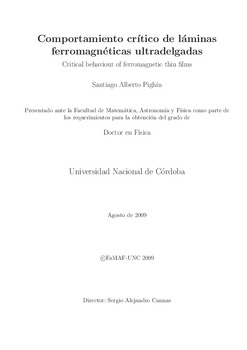| dc.contributor | Cannas, Sergio Alejandro | es |
| dc.contributor.author | Pighín, Santiago Alberto | es |
| dc.date.accessioned | 2011-09-06T15:27:12Z | |
| dc.date.available | 2011-09-06T15:27:12Z | |
| dc.date.issued | 2009-08 | es |
| dc.identifier.citation | Incuye referencias bibliográficas: p. 145-151. | es |
| dc.identifier.uri | http://hdl.handle.net/11086/132 | |
| dc.description | Tesis (Doctor en Física)--Universidad Nacional de Córdoba. Facultad de Matemática, Astronomía y Física, 2009. | es |
| dc.description.abstract | Las láminas ferromagnéticas ultradelgadas son sistemas magnéticos caracterizados por una fuerte anisotropía uniaxial producto del confinamiento del sistema en una de sus direcciones. Ésta favorece el alineamiento de los momentos magnéticos de los átomos perpendicular al plano de la lámina. El orden magnético de estos sistemas es de gran complejidad debido a la competencia entre las interacciones de intercambio y dipolar magnética a diferente escala espacial, además de la presencia de anisotropía.
En el presente trabajo se propone un modelo de espines clásicos en donde se tiene en cuenta la interacción de intercambio (responsable del ordenamiento ferromagnético), anisotrópica (responsable de los ejes de fácil magnetización) y dipolar magnética (responsable de la generación de dominios magnéticos) para explicar la fenomenología. | es |
| dc.description.abstract | Ferromagnetic ultrathin films are characterized by a strong uniaxial anisotropy due to the presence of an interface. This may favor a perpendicular alignment of the magnetic moments within the film. An example of this system is the film obtained by the deposition of Fe on a Cu substrate.
Competition between the short-range exchange interaction and long-range dipolar interaction plus the action of anisotropy generate complex magnetic order. Thin films magnetic properties are strongly dependent on preparation conditions, thickness and temperature. At low temperatures,
the system presents stripes, characterized by a modulation of the perpendicular magnetization in one direction only. When the temperature is increased, the stripes become narrower up to a
transition into a ferromagnetic in-plane state or to a disordered state depending on experimental parameters. The disordering process can be mediated by two disordered phases, the nematic, with π/2 rotational simetry, and the tetragonal liquid, with π/4 rotational simetry.
In the first part, we study the thin-films magnetic properties in the limit of high anisotropy, where the system is described by an Ising with short and long range interactions. We present
a detailed calculation of the (δ,T) phase diagram, δ being the ratio between exchange and dipolar interaction intensities and T the temperature. We compare the results of both mean field
approximation and Monte Carlo numerical simulations in the region of low values of δ. We found
that, in the regions of the phase diagram where Monte Carlo simulations display nematic order,
the mean field approximation predicts hybrid solutions composed by stripes of different widths.
Another remarkable qualitative difference between both calculations is the absence, in this region of the Monte Carlo phase diagram, of the temperature dependency of the equilibrium stripe width predicted by the mean field approximation.
In the second part, we propose a Heisenberg model to account for the behavior at intermediate anisotropies. We calculate the complete zero temperature (δ,η) phase diagram, η being the
ratio between anisotropy and dipolar interaction intensities. Increasing the value of η through the
reorientation phase transition we find three different stripes solutions: a canted phase, with nonzero in-plane magnetization within the domains; a saturated phase, characterized by zero in-plane magnetization within the domains and nonzero within the domains walls; and Ising stripes, with zero in-plane magnetization and sharp walls.
We also present a detailed calculation of the (T,η) phase diagram with δ = 6. We find that the
limit of high η values is consistent with the results obtained with the Ising model. We observe the
reorientation phase transition and stripe width dependence with temperature. The phase diagram presents a scaling law and can be extrapolated to arbitrary values of δ, obtaining a good agreement with experiment. We find that the mechanism mediating stripe width transitions is the dislocation dynamic. This dynamic becomes slower at high η values. Finally, we simulate wedges appreciating the same phenomenology as experimental systems. | en |
| dc.description.statementofresponsibility | Santiago Alberto Pighín. | es |
| dc.format.extent | 151 páginas | es |
| dc.language.iso | spa | es |
| dc.rights | Atribución-NoComercial-SinDerivadas 2.5 Argentina | * |
| dc.rights.uri | http://creativecommons.org/licenses/by-nc-nd/2.5/ar/ | * |
| dc.subject | Domain Structure | en |
| dc.subject | Dynamics properties | en |
| dc.subject | Numerical simulation studies | en |
| dc.subject | Static properties | en |
| dc.subject | Classical spin models | en |
| dc.subject.other | Simulaciones numéricas | es |
| dc.subject.other | Propiedades magnéticas de monocapas y láminas delgadas | es |
| dc.subject.other | Modelos de espines clásicos | es |
| dc.subject.other | Propiedades Dinámicas | es |
| dc.subject.other | Simulaciones de Monte Carlo | es |
| dc.subject.other | Interacciones Competitivas | es |
| dc.title | Comportamiento crítico de láminas ferromagnéticas ultradelgadas | es |
| dc.title.alternative | Critical behaviour of ferromagnetic thin films | en |
| dc.type | doctoralThesis | es |





